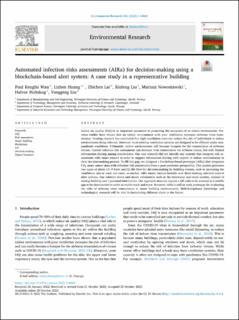| dc.contributor.author | Wan, Paul Kengfai | |
| dc.contributor.author | Huang, Lizhen | |
| dc.contributor.author | Lai, Zhichen | |
| dc.contributor.author | Liu, Xiufeng | |
| dc.contributor.author | Nowostawski, Mariusz | |
| dc.contributor.author | Holtskog, Halvor | |
| dc.contributor.author | Liu, Yongping | |
| dc.date.accessioned | 2023-03-06T16:00:31Z | |
| dc.date.available | 2023-03-06T16:00:31Z | |
| dc.date.created | 2022-11-01T14:18:25Z | |
| dc.date.issued | 2022 | |
| dc.identifier.citation | Environmental Research. 2022, 216 (3), . | en_US |
| dc.identifier.issn | 0013-9351 | |
| dc.identifier.uri | https://hdl.handle.net/11250/3056190 | |
| dc.description.abstract | Indoor air quality (IAQ) is an important parameter in protecting the occupants of an indoor environment. Previous studies have shown that an indoor environment with poor ventilation increases airborne virus transmission. Existing research has concluded that high ventilation rates can reduce the risk of individuals in indoor environments being infected. However, most existing ventilation systems are designed to be efficient under non-pandemic conditions. Ultimately, indoor environments will become hotspots for the transmission of airborne viruses. Current infection risk assessments can estimate virus transmission via airborne routes, but with limited information sharing among stakeholders. Our own research did not identify any systems that integrate risk assessments with smart sensors in order to support information sharing with experts in indoor environments in their decision-making process. To fill this gap, we designed a blockchain-based prototype (AIRa) that integrates CO2 smart sensor data with infection risk assessments from a post-pandemic perspective. This system generates two types of alerts: (1) P-Alert and (2) R0-Alert for decision-making by building owners, such as increasing the ventilation rate or track and trace, as needed. AIRa shows various benefits over three existing infection-control alert systems. Our solution stores and shares information such as the timestamp and room number, instead of storing building user's personal information. Our approach does not require a QR code to be scanned or a mobile app to be downloaded in order to enable track and trace. However, AIRa is still an early prototype for evaluating the risks of airborne virus transmission in smart building environments. Multidisciplinary knowledge and technological research will be vital in formulating different alerts in the future. | en_US |
| dc.language.iso | eng | en_US |
| dc.publisher | Elsevier | en_US |
| dc.rights | Navngivelse 4.0 Internasjonal | * |
| dc.rights.uri | http://creativecommons.org/licenses/by/4.0/deed.no | * |
| dc.title | Automated infection risks assessments (AIRa) for decision-making using a blockchain-based alert system: A case study in a representative building | en_US |
| dc.title.alternative | Automated infection risks assessments (AIRa) for decision-making using a blockchain-based alert system: A case study in a representative building | en_US |
| dc.type | Peer reviewed | en_US |
| dc.type | Journal article | en_US |
| dc.description.version | publishedVersion | en_US |
| dc.source.pagenumber | 11 | en_US |
| dc.source.volume | 216 | en_US |
| dc.source.journal | Environmental Research | en_US |
| dc.source.issue | 3 | en_US |
| dc.identifier.doi | 10.1016/j.envres.2022.114663 | |
| dc.identifier.cristin | 2067454 | |
| dc.relation.project | Norges teknisk-naturvitenskapelige universitet: 2041854 | en_US |
| cristin.ispublished | true | |
| cristin.fulltext | original | |
| cristin.qualitycode | 2 | |

